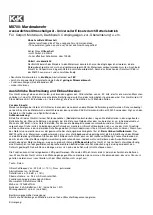
23
Set Up
Blood Pressure Arm
Fig 62.
Fig 63.
Performing a Blood Pressure
1. Verify the pressure line tubing from the
sphygmomanometer and the audio line from
the arm are properly connected to the electronic
control unit. (See above connection instructions)
2. Apply the sphygmomanometer cuff and gauge
to the arm according to facility procedures.
3. Place the stethoscope to the arm according to
facility procedures.
4. Set the systolic and diastolic pressure to the
desired levels.
5. Select the auscultatory gap.
6. Select the heart rate to the desired setting.
Note: The electronic control unit will default to
the last levels previously set. It is important to go
through all menus and program the electronic
control unit with each training session as desired.
A standard stethoscope will work with the blood
pressure simulator, one is not provided. Low
Battery Indicator
When the battery supply diminishes to a level near
the point the unit will no longer function properly,
a “low batt” message will display on the systolic
pressure menu when the systolic pressure reaches
above 20 mmHg. At this point, the batteries should
be replaced as soon as possible to ensure proper
operation of the unit. Refer to the section “Installing
the Batteries” for more information.
Calibration Procedures
1. Follow the setup procedures.
2. Apply the cuff to the simulated arm.
3. Set the electronic control unit systolic pressure
to 150 mmHg and set the diastolic pressure to 70
mmHg.
4. Proceed with performing the blood pressure and
note the differences between the gauge and
what was set on the electronic control unit.
5. Set the systolic
correction by pressing
and holding the
CALIBRATE key to the
right of the GAP key.
(See Figure 62).
6. Using the arrow keys, set the correction. For
example, if the blood pressure reading for systolic
pressure was 148 mmHg, the systolic correction
would be +2 and the up arrow key would be
pressed until +2 would display in the window.
7. Press the MENU key
from the Systolic
Correction window
to change to the
Diastolic Correction
window. (See Figure
63).
8. Using the arrow keys, set the correction. For
example, if the blood pressure reading for
diastolic pressure was 72 mmHg, the diastolic
correction would be -2 and the down arrow
would be pressed until -2 would display in the
window.
9. Press the MENU key. The “CALIBRATION
COMPLETE” message will appear and the main
menu window will be displayed.
















































